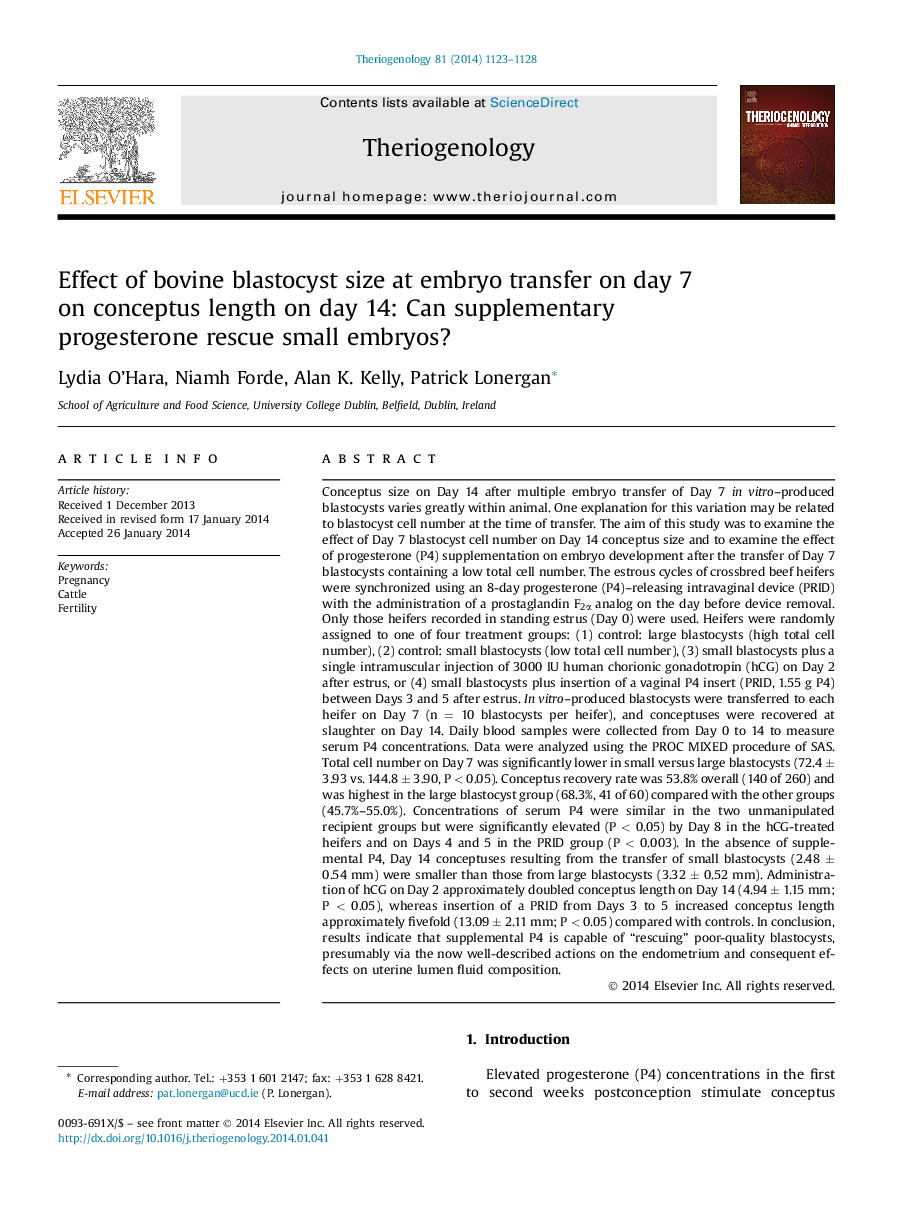| Article ID | Journal | Published Year | Pages | File Type |
|---|---|---|---|---|
| 10891913 | Theriogenology | 2014 | 6 Pages |
Abstract
Conceptus size on Day 14 after multiple embryo transfer of Day 7 in vitro-produced blastocysts varies greatly within animal. One explanation for this variation may be related to blastocyst cell number at the time of transfer. The aim of this study was to examine the effect of Day 7 blastocyst cell number on Day 14 conceptus size and to examine the effect of progesterone (P4) supplementation on embryo development after the transfer of Day 7 blastocysts containing a low total cell number. The estrous cycles of crossbred beef heifers were synchronized using an 8-day progesterone (P4)-releasing intravaginal device (PRID) with the administration of a prostaglandin F2α analog on the day before device removal. Only those heifers recorded in standing estrus (Day 0) were used. Heifers were randomly assigned to one of four treatment groups: (1) control: large blastocysts (high total cell number), (2) control: small blastocysts (low total cell number), (3) small blastocysts plus a single intramuscular injection of 3000 IU human chorionic gonadotropin (hCG) on Day 2 after estrus, or (4) small blastocysts plus insertion of a vaginal P4 insert (PRID, 1.55 g P4) between Days 3 and 5 after estrus. In vitro-produced blastocysts were transferred to each heifer on Day 7 (n = 10 blastocysts per heifer), and conceptuses were recovered at slaughter on Day 14. Daily blood samples were collected from Day 0 to 14 to measure serum P4 concentrations. Data were analyzed using the PROC MIXED procedure of SAS. Total cell number on Day 7 was significantly lower in small versus large blastocysts (72.4 ± 3.93 vs. 144.8 ± 3.90, P < 0.05). Conceptus recovery rate was 53.8% overall (140 of 260) and was highest in the large blastocyst group (68.3%, 41 of 60) compared with the other groups (45.7%-55.0%). Concentrations of serum P4 were similar in the two unmanipulated recipient groups but were significantly elevated (P < 0.05) by Day 8 in the hCG-treated heifers and on Days 4 and 5 in the PRID group (P < 0.003). In the absence of supplemental P4, Day 14 conceptuses resulting from the transfer of small blastocysts (2.48 ± 0.54 mm) were smaller than those from large blastocysts (3.32 ± 0.52 mm). Administration of hCG on Day 2 approximately doubled conceptus length on Day 14 (4.94 ± 1.15 mm; P < 0.05), whereas insertion of a PRID from Days 3 to 5 increased conceptus length approximately fivefold (13.09 ± 2.11 mm; P < 0.05) compared with controls. In conclusion, results indicate that supplemental P4 is capable of “rescuing” poor-quality blastocysts, presumably via the now well-described actions on the endometrium and consequent effects on uterine lumen fluid composition.
Related Topics
Life Sciences
Agricultural and Biological Sciences
Animal Science and Zoology
Authors
Lydia O'Hara, Niamh Forde, Alan K. Kelly, Patrick Lonergan,
